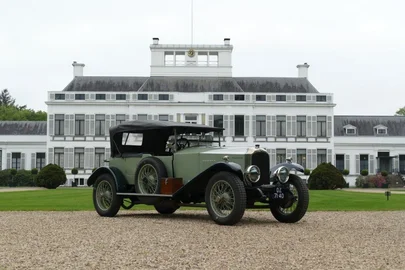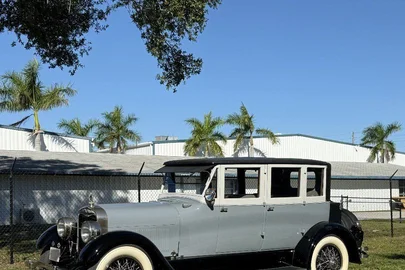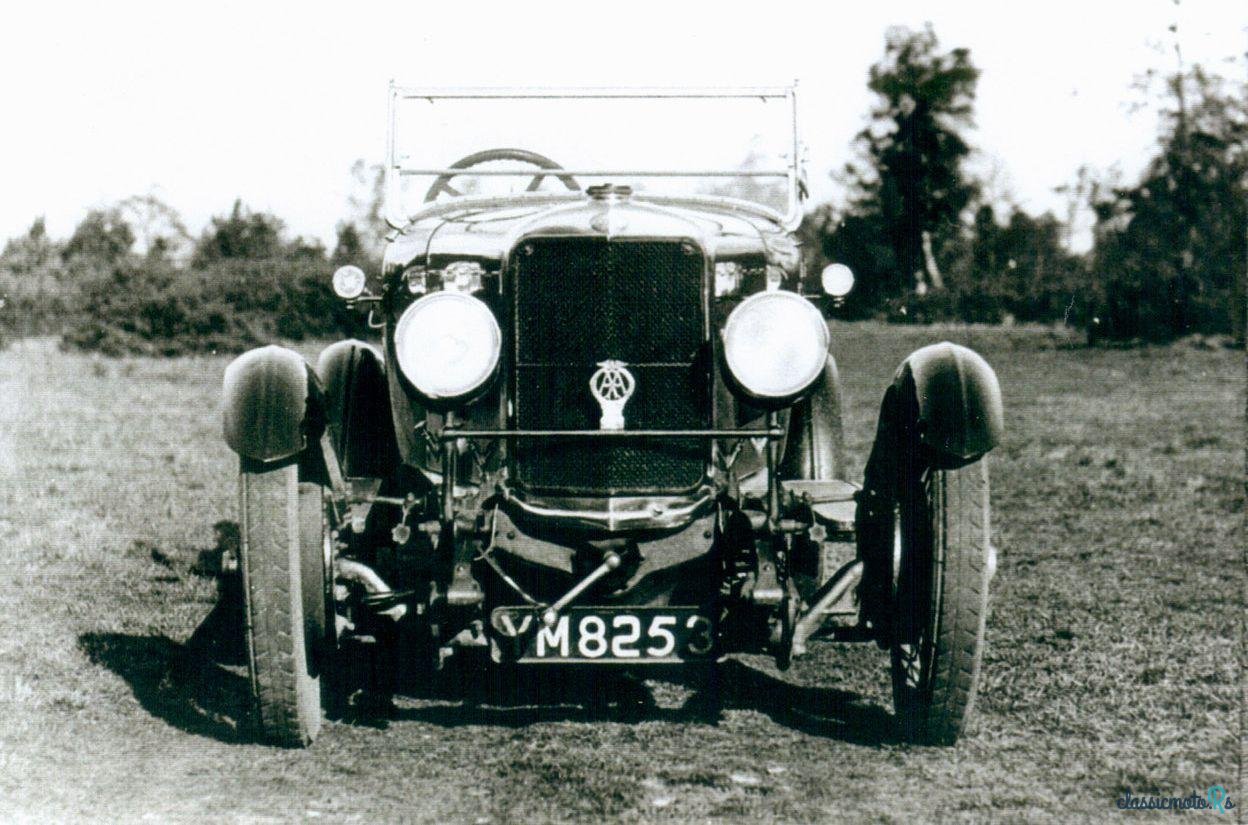
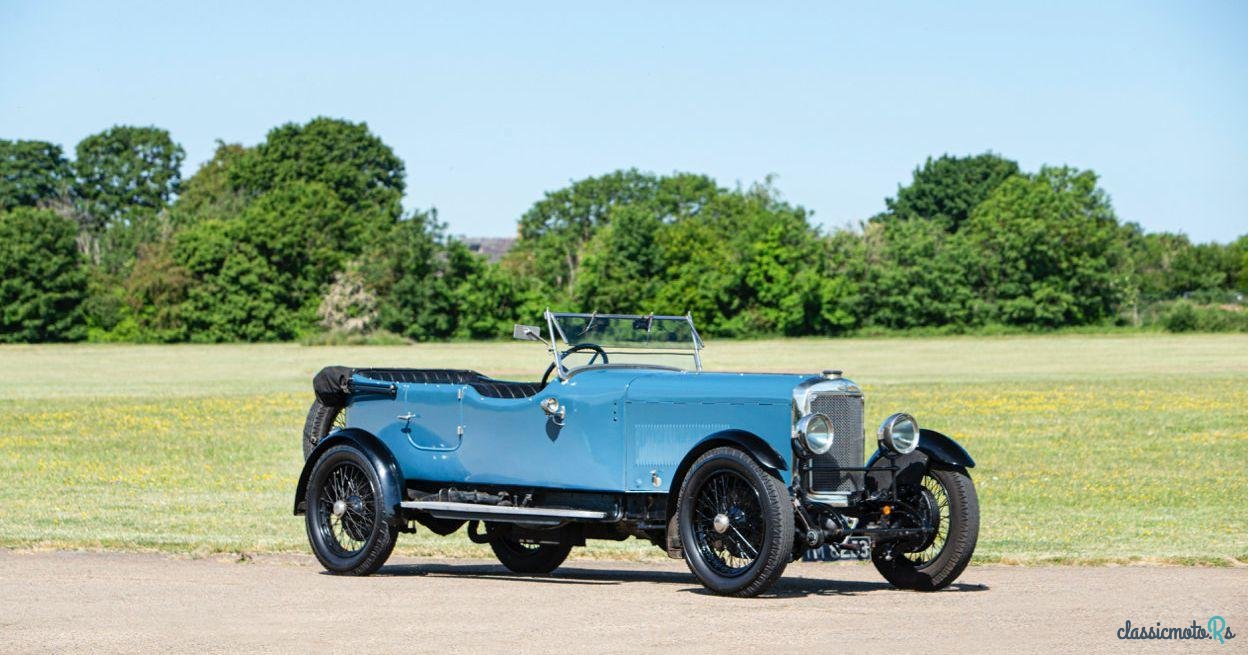

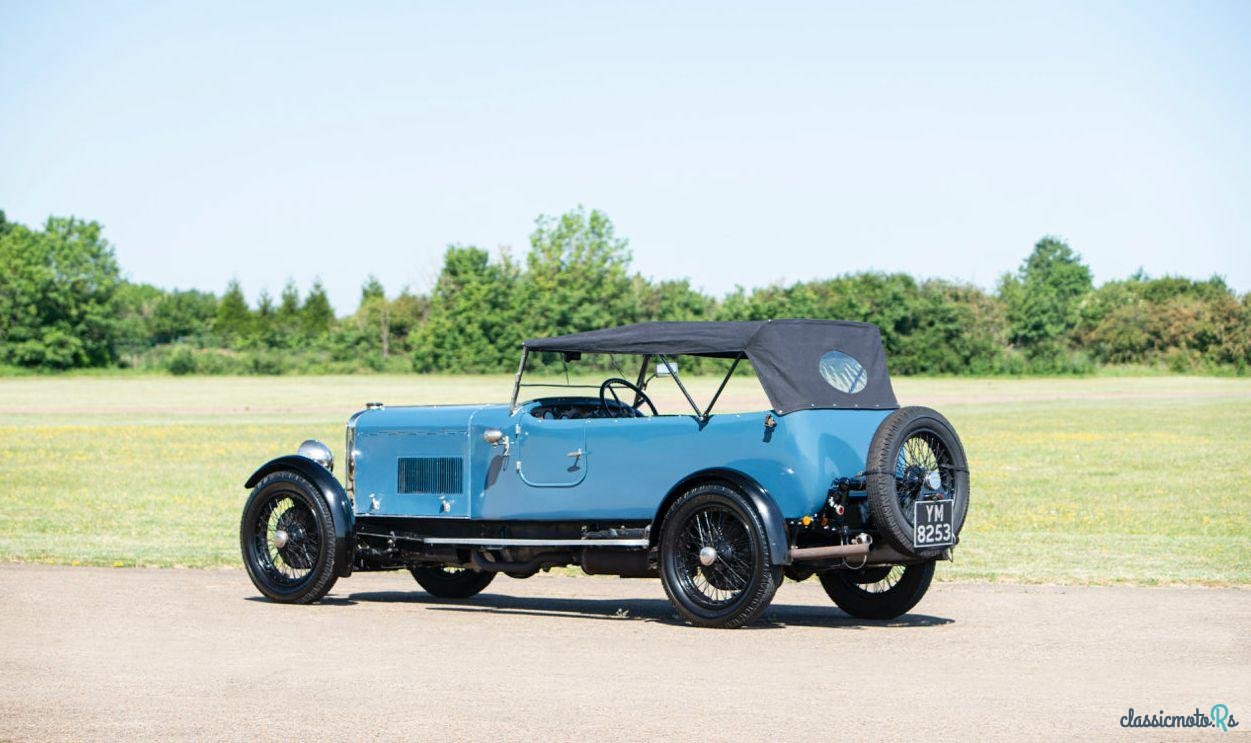
4 photos
1925' Sunbeam 3-Litre Twin Cam Super Sports
Report This Ad!Rate This!Bookmark This
NegotiablePublished 28 August 2020ID: blSgk6
Expired
5 years, 4 months ago
5 years, 4 months ago
Information from the owner
Body: Sports Car
Age: 95 years
Exterior color: Blue
Seller's comments about 1925' Sunbeam 3-Litre Twin Cam Super Sports
One of the most original of the 45 surviving examples,
1925 Sunbeam 3-Litre “Twin Cam” Super Sports
Chassis No. 4028 FE
Engine No. 4053E
Body No. 4028
Registration No. YM 8253
Presented for sale here is a superb example of one of the most refined and exciting vintage sports tourers ever conceived – namely the Sunbeam 3-Litre “Twin Cam” Super Sports. Not only is it one of the most original of the surviving Super Sports, but it is also one of the prettiest. To cap it all, this fine Sunbeam has a fully documented history from new and has been the recipient of extensive mechanical works carried out by the guru of the “Twin Cams” himself, Dr. James “Jim Catnach. It is a motorcar in which it is difficult to find any fault at all and thus we are delighted to have been entrusted with its sale.
Sunbeam & Motor Sport
To fully comprehend Sunbeam’s ability to produce a high-quality sports car, it is important to first illustrate some of the incredible achievements of their competition department. Their contribution to international motor sporting success is perhaps greater than that of any other British motorcar manufacturer before the outbreak of World War II. From the early days of motoring up until the late 1920s it was Sunbeam that waved the British flag, with considerable success at the highest levels of international motorsport, in all its forms. Whilst the magnitude of their success is indisputable, it is nonetheless, often overlooked.
A recent edition of The Automobile Magazine (Vol 38, No. 3 – May 2020 Ed.) features a beautifully written article by motoring historian, Oliver Heal on the 1000HP Sunbeam, a car that was to decimate the previous Land Speed Record by breaking the 200mph mark on land for the first time in 1927. In said article, despite being handicapped, as most authors are by limited column inches, Heal manages to successfully and succinctly convey the significance of what the Wolverhampton based firm achieved under the command of the brilliant Louis Coatalen. Being a less successful author than Heal by some considerable margin, a listing will be employed here to demonstrate the point:
• 1st 2nd & 3rd places in the 1912 Coupe de L’Auto Race – the first significant international race victory for a British firm in a decade
• 1st place in the French Grand Prix of 1923 – the first British victory in a Grand Prix and the last British victory at that race until 1960
• 1st place in the 1924 San Sebastian Grand Prix – the last victory for a British car and driver combination until 1955
• 152mph in 1925 with Tiger – an astonishing achievement for a 4-Litre V12 motorcar which produced some 300bhp
• 203.7926mph in 1927 with the 1000HP Sunbeam – a motorcar which had a body designed using wind tunnel technology
The Sunbeam Motor Car Co. Ltd. had produced a six-cylinder twin overhead-camshaft engine before The First World War and had even competed at Indianapolis. They were, in essence, the only major British producer of purebred racing cars before The Second World War and certainly the most successful at international Grand Prix level.
The Sunbeam 3-Litre Super Sports
Drawing on their considerable experience with twin overhead camshaft technology, that predated The First World War, Sunbeam introduced the “Super Sports” model in 1924. Powered by a 3-Litre six-cylinder twin-overhead camshaft engine the car was undoubtedly one of the finest sports cars available worldwide and bettered the 3-Litre Bentleys in performance – as the result at the 1925 Le Mans race showed. Aside from their Grand Prix, Indianapolis and Land Speed Record successes, Sunbeam’s first and only major attempt at the Le Mans 24-Hour Race took place in 1925 and resulted in Sir Henry Seagrave leading for the first hour and Sammy Davis finishing a highly creditable 2nd overall – in turn beating the Bentleys. The firms only other major attempt at sports car racing came in 1929 for the International Irish grand Prix at Phoenix Park, where the addition of a supercharger allowed Sir Malcolm Campbell to put in lap speeds as faster than the winning Alfa Romeo but where the increased power caused the clutch to fail. In truth, Sunbeam never really focussed on sports car racing, but given that they were able to compete with the mighty European teams at Grand Prix level, it is likely that with the Super Sports “Twin Cam” Model they could have been victorious at Le Mans and many other events had the Land Speed Record program been higher up the agenda by that point.
The Motor Car Offered
This beautiful early Sunbeam 3-Litre Super Sports, Chassis no. 4028FE, was registered YM 8253, a London number, in late 1925. The original body is Sunbeam’s own and was finished in Cambridge Blue. The first report of the car is when a gentleman named Mr. Smith from Cambridge University competed in the Inter-Varsity Hill Climb at Henley and the ascent was pictured in the 9th March 1926 edition of The Motor. A copy of this article is contained within the history file offered with the car. Being a late Sanction E model, ‘YM 8253’ benefits from the lower bodyline of the earlier cars, whilst featuring a number of improvements made to the later cars. Mr. Smith appears to have retained ownership of the Sunbeam until 1933. The subsequent ownership history is also on file and can be supplied in full to interested parties.
Gratifyingly this superb example of the Super Sports remains largely original and has been particularly well cared for in recent years. When Bert Smith acquired the Sunbeam in 1962 the cylinder block had failed, but he was able to source a replacement and was able to get ‘YM 8253’ back on the road. The bodywork is original and was sympathetically restored by Bill Barrott during the 1990s with the emphasis on conservation rather than replacement. It is thought that the upholstery is almost entirely original, yet remains in beautiful condition throughout. Furthermore, the instrument panel is also original aside from the temperature gauge and features Sunbeam’s unique hand throttle control that gives the impression that, when operating the throttle by hand, one might be cracking into a safe! It is also, of course, extremely useful when warming up the delectable sounding straight-six twin-overhead camshaft engine.
In 2009 the engine was the subject of a complete top-end rebuild and was fitted with new Arias pistons by marque expert Jim Catnach. In 2013 the engine was again entrusted to Jim Catnach who stripped it down completely, rebuilt the bottom end, oil pumps, and crank-shaft bearings. The bottom-end has a nickel chromium crankshaft fitted with shell bearings and thus retains excellent oil pressure. ‘YM 8253’ subsequently passed to Raul St Georgi who in turn purchased a new block casting from Jim Catnach in 2014. The block was milled in Belgium to a high standard however the car was purchased by the current owner in England before the local team could complete the rebuild. At this stage ‘YM 8253’ was returned to Jim Catnach where a full rebuild of the engine was completed. The new cylinder block was stripped and both the top and bottom end were rebuilt including: re-machining plug holes, adjustment of the timing gears, profiling and adjustment of the cams, re-machining the crankshaft, bearing housings and seals. The car now has a brand new “Catnach block” with a guarantee that the casting is sound. The new cylinder block has much improved internal cooling arrangement and wall thickening than the original.
This very well sorted Sunbeam has been extensively campaigned on Continental and British rallies, including the Classic Le Mans and Paris-Deauville and competed for the Pomeroy Trophy at Silverstone in 2018 and 2019. It also featured at the celebration run at Southport Sands for the 90th anniversary of Sunbeam’s land speed record, surely Coatalen would approve! ‘YM 8253’ is offered for sale with an extensive history file, documenting its ownership history from new, the extensive and yet sympathetic works carried out both cosmetically and mechanically, together with a large selection of photographs showing the car from its earliest days to the present day.
For a car to look right is hard enough, and there have been many failed attempts at this, but for a car to feel right it must be the subject of the love and care of enthusiastic owners over the years. One cannot create this feel in a workshop, it is earned by the life that the car leads. When viewing this fine Sunbeam Super Sports it is clear from first sight that ‘YM 8253’ has lead such a life. It is one of those rare cars that not only looks right, but also feels exactly right. When cleaning the car for photography, the hairbands of the owner’s daughters were found under the rear seats – surely a sign that this fabulous “Twin Cam” has been loved and enjoyed by the current owner and all of his family.
Of the original production run of 315, only around 45 of the Sunbeam 3-Litre “Twin Cam” Super Sports are known to have survived and thus rarely does the opportunity arise to acquire such a fine example of this rare and exciting thoroughbred British sports car.
1925 Sunbeam 3-Litre “Twin Cam” Super Sports
Chassis No. 4028 FE
Engine No. 4053E
Body No. 4028
Registration No. YM 8253
Presented for sale here is a superb example of one of the most refined and exciting vintage sports tourers ever conceived – namely the Sunbeam 3-Litre “Twin Cam” Super Sports. Not only is it one of the most original of the surviving Super Sports, but it is also one of the prettiest. To cap it all, this fine Sunbeam has a fully documented history from new and has been the recipient of extensive mechanical works carried out by the guru of the “Twin Cams” himself, Dr. James “Jim Catnach. It is a motorcar in which it is difficult to find any fault at all and thus we are delighted to have been entrusted with its sale.
Sunbeam & Motor Sport
To fully comprehend Sunbeam’s ability to produce a high-quality sports car, it is important to first illustrate some of the incredible achievements of their competition department. Their contribution to international motor sporting success is perhaps greater than that of any other British motorcar manufacturer before the outbreak of World War II. From the early days of motoring up until the late 1920s it was Sunbeam that waved the British flag, with considerable success at the highest levels of international motorsport, in all its forms. Whilst the magnitude of their success is indisputable, it is nonetheless, often overlooked.
A recent edition of The Automobile Magazine (Vol 38, No. 3 – May 2020 Ed.) features a beautifully written article by motoring historian, Oliver Heal on the 1000HP Sunbeam, a car that was to decimate the previous Land Speed Record by breaking the 200mph mark on land for the first time in 1927. In said article, despite being handicapped, as most authors are by limited column inches, Heal manages to successfully and succinctly convey the significance of what the Wolverhampton based firm achieved under the command of the brilliant Louis Coatalen. Being a less successful author than Heal by some considerable margin, a listing will be employed here to demonstrate the point:
• 1st 2nd & 3rd places in the 1912 Coupe de L’Auto Race – the first significant international race victory for a British firm in a decade
• 1st place in the French Grand Prix of 1923 – the first British victory in a Grand Prix and the last British victory at that race until 1960
• 1st place in the 1924 San Sebastian Grand Prix – the last victory for a British car and driver combination until 1955
• 152mph in 1925 with Tiger – an astonishing achievement for a 4-Litre V12 motorcar which produced some 300bhp
• 203.7926mph in 1927 with the 1000HP Sunbeam – a motorcar which had a body designed using wind tunnel technology
The Sunbeam Motor Car Co. Ltd. had produced a six-cylinder twin overhead-camshaft engine before The First World War and had even competed at Indianapolis. They were, in essence, the only major British producer of purebred racing cars before The Second World War and certainly the most successful at international Grand Prix level.
The Sunbeam 3-Litre Super Sports
Drawing on their considerable experience with twin overhead camshaft technology, that predated The First World War, Sunbeam introduced the “Super Sports” model in 1924. Powered by a 3-Litre six-cylinder twin-overhead camshaft engine the car was undoubtedly one of the finest sports cars available worldwide and bettered the 3-Litre Bentleys in performance – as the result at the 1925 Le Mans race showed. Aside from their Grand Prix, Indianapolis and Land Speed Record successes, Sunbeam’s first and only major attempt at the Le Mans 24-Hour Race took place in 1925 and resulted in Sir Henry Seagrave leading for the first hour and Sammy Davis finishing a highly creditable 2nd overall – in turn beating the Bentleys. The firms only other major attempt at sports car racing came in 1929 for the International Irish grand Prix at Phoenix Park, where the addition of a supercharger allowed Sir Malcolm Campbell to put in lap speeds as faster than the winning Alfa Romeo but where the increased power caused the clutch to fail. In truth, Sunbeam never really focussed on sports car racing, but given that they were able to compete with the mighty European teams at Grand Prix level, it is likely that with the Super Sports “Twin Cam” Model they could have been victorious at Le Mans and many other events had the Land Speed Record program been higher up the agenda by that point.
The Motor Car Offered
This beautiful early Sunbeam 3-Litre Super Sports, Chassis no. 4028FE, was registered YM 8253, a London number, in late 1925. The original body is Sunbeam’s own and was finished in Cambridge Blue. The first report of the car is when a gentleman named Mr. Smith from Cambridge University competed in the Inter-Varsity Hill Climb at Henley and the ascent was pictured in the 9th March 1926 edition of The Motor. A copy of this article is contained within the history file offered with the car. Being a late Sanction E model, ‘YM 8253’ benefits from the lower bodyline of the earlier cars, whilst featuring a number of improvements made to the later cars. Mr. Smith appears to have retained ownership of the Sunbeam until 1933. The subsequent ownership history is also on file and can be supplied in full to interested parties.
Gratifyingly this superb example of the Super Sports remains largely original and has been particularly well cared for in recent years. When Bert Smith acquired the Sunbeam in 1962 the cylinder block had failed, but he was able to source a replacement and was able to get ‘YM 8253’ back on the road. The bodywork is original and was sympathetically restored by Bill Barrott during the 1990s with the emphasis on conservation rather than replacement. It is thought that the upholstery is almost entirely original, yet remains in beautiful condition throughout. Furthermore, the instrument panel is also original aside from the temperature gauge and features Sunbeam’s unique hand throttle control that gives the impression that, when operating the throttle by hand, one might be cracking into a safe! It is also, of course, extremely useful when warming up the delectable sounding straight-six twin-overhead camshaft engine.
In 2009 the engine was the subject of a complete top-end rebuild and was fitted with new Arias pistons by marque expert Jim Catnach. In 2013 the engine was again entrusted to Jim Catnach who stripped it down completely, rebuilt the bottom end, oil pumps, and crank-shaft bearings. The bottom-end has a nickel chromium crankshaft fitted with shell bearings and thus retains excellent oil pressure. ‘YM 8253’ subsequently passed to Raul St Georgi who in turn purchased a new block casting from Jim Catnach in 2014. The block was milled in Belgium to a high standard however the car was purchased by the current owner in England before the local team could complete the rebuild. At this stage ‘YM 8253’ was returned to Jim Catnach where a full rebuild of the engine was completed. The new cylinder block was stripped and both the top and bottom end were rebuilt including: re-machining plug holes, adjustment of the timing gears, profiling and adjustment of the cams, re-machining the crankshaft, bearing housings and seals. The car now has a brand new “Catnach block” with a guarantee that the casting is sound. The new cylinder block has much improved internal cooling arrangement and wall thickening than the original.
This very well sorted Sunbeam has been extensively campaigned on Continental and British rallies, including the Classic Le Mans and Paris-Deauville and competed for the Pomeroy Trophy at Silverstone in 2018 and 2019. It also featured at the celebration run at Southport Sands for the 90th anniversary of Sunbeam’s land speed record, surely Coatalen would approve! ‘YM 8253’ is offered for sale with an extensive history file, documenting its ownership history from new, the extensive and yet sympathetic works carried out both cosmetically and mechanically, together with a large selection of photographs showing the car from its earliest days to the present day.
For a car to look right is hard enough, and there have been many failed attempts at this, but for a car to feel right it must be the subject of the love and care of enthusiastic owners over the years. One cannot create this feel in a workshop, it is earned by the life that the car leads. When viewing this fine Sunbeam Super Sports it is clear from first sight that ‘YM 8253’ has lead such a life. It is one of those rare cars that not only looks right, but also feels exactly right. When cleaning the car for photography, the hairbands of the owner’s daughters were found under the rear seats – surely a sign that this fabulous “Twin Cam” has been loved and enjoyed by the current owner and all of his family.
Of the original production run of 315, only around 45 of the Sunbeam 3-Litre “Twin Cam” Super Sports are known to have survived and thus rarely does the opportunity arise to acquire such a fine example of this rare and exciting thoroughbred British sports car.


